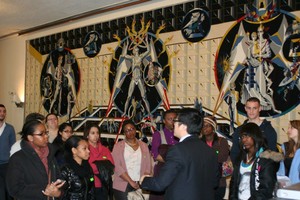 We had the pleasure of hosting a group of students and staff from Bloomfield College today and toured the UN building before returning to the office to hear speakers on several topics. By walking through the rooms of the United Nations (including the General Assembly hall, where Secretary General Ban Ki-Moon was present and the General Assembly was in session to launch the “Year of Quinoa”), the group gained greater awareness of how the United Nations system functions (resolutions of the UN Security Council are legally binding, while resolutions of the General Assembly carry the moral weight of the world). We saw anti-personnel landmines, which cost about $3 to make, last for years (or decades) after the conflict, and can kill or impair a person for life. A few recruits from the group were made into UN Peacekeepers who created a buffer zone between two nations in conflict (one brave soul from the group and our tour guide). Given the current nature of conflict, Peacekeepers do much more too (some are engineers, some doctors, for example).
We had the pleasure of hosting a group of students and staff from Bloomfield College today and toured the UN building before returning to the office to hear speakers on several topics. By walking through the rooms of the United Nations (including the General Assembly hall, where Secretary General Ban Ki-Moon was present and the General Assembly was in session to launch the “Year of Quinoa”), the group gained greater awareness of how the United Nations system functions (resolutions of the UN Security Council are legally binding, while resolutions of the General Assembly carry the moral weight of the world). We saw anti-personnel landmines, which cost about $3 to make, last for years (or decades) after the conflict, and can kill or impair a person for life. A few recruits from the group were made into UN Peacekeepers who created a buffer zone between two nations in conflict (one brave soul from the group and our tour guide). Given the current nature of conflict, Peacekeepers do much more too (some are engineers, some doctors, for example).
Kevin Cassidy told about the the International Labour Organization (ILO), a UN agency which works worldwide with issues related to employment, working conditions, and trafficked and exploited workers. He gave us poignant examples of the ILO’s work with an exploited farm laborer in Brazil and a girl trafficked into the sex trade in Thailand. Mr. Cassidy promoted the improvement of working conditions as just for workers as well as often beneficial to a company’s bottom-line, as productivity is improved and good ideas from workers may be broadly applied.
Carol Smolenski of ECPAT-USA (End Child Prostitution and Trafficking) built on what Mr. Cassidy and Ryan Smith (of our office, who addressed human trafficking, particularly in relation to child soldiers). She spoke about the trafficking of children for the sex trade, and showed a compelling short film (What I Have Been Through is Not Who I Am) about the experiences of victims of child sex trafficking in our own nation. While there have been improvements in recent years, the justice systems of many US states are still ill-equipped to respond to trafficking and often incarcerate victims instead of providing the help they need to leave “the life” of prostitution and trafficking (US law provides that the exploitation of anyone under 18 in the sex trade constitutes sex trafficking). The problem is pervasive, and ideas of prostitution as a victimless crime lets many pimps and clients go about their immoral business with impunity, while trafficked children are trapped in a cycle of constant sexual, physical, and emotional abuse.
Evil is real. So what can we do? We can get involved and organize small groups to learn and speak out; we can write to our legislators in support of responsible responses to human trafficking. We can vote with our pocketbooks and ask our hotels and travel agencies to put in place policies against sex tourism. We can demand justice for exploited workers and make it clear in our communities that pimps and prostitution’s clients are committing crimes that are far from victimless. And always, we must pray for our world and especially for the victims of human trafficking.
The lesson of the day, to sum it up in the words of Jana Stanfield, (and tweeted by UNICEF) is “I cannot do all the good that the world needs, but the world needs all the good that I can do.”
Alexander Haines, author and photographer, is a third-year student at Princeton Theological Seminary who is doing a field education placement with the Presbyterian Ministry at the United Nations.